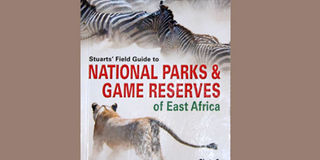Cheers to new East Africa’s travel mate

Stuarts’ Field Guide to National Parks & Game Reserves of East Africa. PHOTO | COURTESY
What you need to know:
- I like guidebooks. I must have some kind of guide for every country I have been lucky enough to visit.
I like guidebooks. I must have some kind of guide for every country I have been lucky enough to visit. Yes, I know I can get the information on my computer or my phone. But I like books — like the feel of them; like to have one by me in the car.
There is a new one out. It’s the Stuarts’ Field Guide to National Parks & Game Reserves of East Africa. The guide is written by a husband and wife team, Chris and Mathilde Stuart, who have produced so many books on wildlife and conservation. And, lucky couple, they have visited over 50 countries together.
In this guide, Chris and Mathilde describe 58 of the parks and reserves across the four countries of Kenya, Tanzania, Uganda and Rwanda. For each park, they give background information on its geology and landscape, its climate, vegetation and wildlife. In addition, there are many colour photographs of the common — and not so common — animals and plant life you can see there. And there are park maps, indicating the places of particular interest and the places where you can find the key species.
In the introduction to the guide, the two authors tell us that they have two main aims: to outline the natural history of the best conservation areas that East Africa has to offer, and to assist visitors in identifying the more common mammals, birds, reptiles, amphibians, trees and plants in these areas. So, after the main guide to the parks, the book has a splendid photographic gallery for a, hopefully, quick identification of what you are looking at through your binoculars.
Some years ago, back in England and at a graduation party for one of my daughters, I realised that I was the only one sitting around a large table of people born before Kenya’s independence. So I launched into an impromptu, informal, and no doubt unscientific, survey about their knowledge of Kenya. Apart from my daughter, who was born here in Nairobi, none of the others knew whether Kenya was in the East or West of Africa, and only one could name the country’s first President.
But, when asked about the landscape of Kenya, all of the youngsters had — I guess from many safari and wildlife documentaries popular at the time on TV — an image of rolling savannah grasslands, dotted with umbrella-shaped thorn trees.
After reading the introductory section of the book, I decided to test out the park descriptions by looking at the first national park we had visited outside Kenya. It was back in the late 1960s. The park was the Lake Manyara National Park in Tanzania, which is close to the town of Mto wa Mbu — the ‘Place of the Mosquito’ — and on the main route that links Arusha with Serengeti.
I well remember the view from the escarpment lodge we stayed in — down to the woodlands of the park and across to the lake. I wanted the name of the lodge, but I discovered that Chris and Mathilde’s book doesn’t deal with accommodation. That’s OK, isn’t it? In the main, the landscapes and the wildlife stay the same; the lodges and camps change. Best to use the computer and the phone to find out about those.
John Fox is Managing Director of iDC





